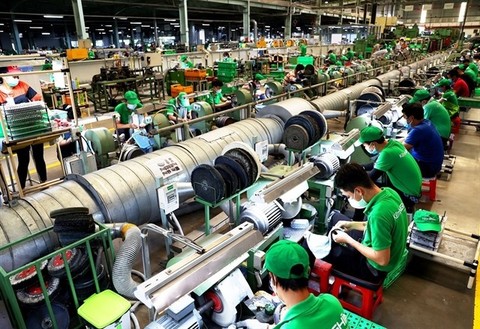
A company in HCM City. With new orders rising sharply, manufacturers ramped up production in July. — VNA/VNS Photo
The strong growth in the Vietnamese manufacturing sector seen in June was sustained in July.
A further substantial rise in new orders led manufacturers to ramp up production, with the rate of growth quickening to a near-record high.
The S&P Global Vietnam Manufacturing Purchasing Managers' Index (PMI) was unchanged at 54.7 in July, signalling a further marked strengthening of business conditions in the Vietnamese manufacturing sector.
Andrew Harker, Economics Director at S&P Global Market Intelligence, said: “The fact that the Vietnamese manufacturing sector was able to sustain the strong expansion seen in June through into July adds to optimism that we are at the start of a good spell of growth that will help drive the wider economy forward.
"The main issue for firms at present is keeping up with demand. While production was ramped up, firms were still forced to dip into warehouse stocks to help meet new order requirements, resulting in one of the sharpest depletions of inventories on record.
"Manufacturers will need to expand workforce numbers more quickly and continue to secure additional materials should current trends in new orders be sustained in the months ahead."
In fact, the last time that growth was faster was in November 2018. Marked improvements were seen across the consumer, intermediate and investment goods categories.
New orders increased for the fourth month running in July, with the rate of expansion only slightly slower than the near record posted in June.
Where new business rose, panellists linked this to stronger market demand and an increase in customer numbers. New export orders also rose, albeit at a much softer pace than total new business. Some firms reported that export demand had been hampered by high shipping costs.
With new orders rising sharply, manufacturers ramped up production in July. Moreover, the rate of expansion in output quickened from that seen in June and was the second-fastest on record, just behind that seen in the opening month of data collection in March 2011.
Despite the sharp increase in output, firms needed to dip into existing stockpiles to help meet new order requirements. In fact, stocks of finished goods were depleted to the second largest degree on record, behind only that seen in February 2014.
Firms made efforts to expand capacity by increasing both their purchasing activity and employment at the start of the third quarter. Input buying rose markedly and at the fastest pace since May 2022. Staffing levels, on the other hand, increased only modestly and at a softer pace than in June. Meanwhile, backlogs of work accumulated for the second consecutive month.
Manufacturers were helped in their desire to secure materials by a second successive monthly shortening of suppliers' delivery times, although the degree of improvement in vendor performance was only marginal amid some reports of delays to sea transportation.
Stocks of purchases decreased for the eleventh month running and at a solid pace that was the sharpest since April. Input costs continued to increase sharply during July, with the pace of inflation only marginally weaker than the two-year high seen in June. Suppliers had reportedly raised their charges, while increased shipping costs were also a factor.
Rising costs for raw materials and shipping meant that manufacturers increased their own selling prices for the third month running in July. The rate of inflation was solid, albeit softer than that seen in the previous survey period.
Expectations that new orders will continue to rise over the coming year supported confidence in the outlook for production. Around 40 per cent of respondents expressed optimism, but sentiment eased to the lowest since January and was weaker than the series average. — VNS